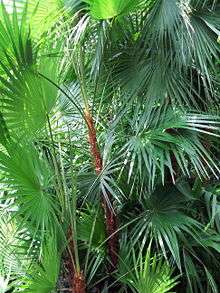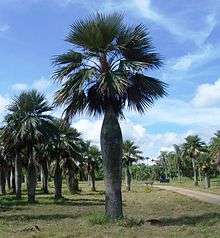Trachycarpeae
Trachycarpeae is a tribe of palms in subfamily Coryphoideae of the plant family Arecaceae. It has the widest distribution of any tribe in Coryphoideae and is found on all continents (except Antarctica), though the greatest concentration of species is in Southeast Asia.[1] Trachycarpeae includes palms from both tropical and subtropical zones; the northernmost naturally-occurring palm is a member of this tribe (Chamaerops humilis).[2] Several genera can be found in cultivation in temperate areas, for example species of Trachycarpus, Chamaerops, Rhapidophyllum and Washingtonia.[3]
| Trachycarpeae | |
|---|---|
| Johannesteijsmannia altifrons | |
| Scientific classification | |
| Kingdom: | Plantae |
| Clade: | Tracheophytes |
| Clade: | Angiosperms |
| Clade: | Monocots |
| Clade: | Commelinids |
| Order: | Arecales |
| Family: | Arecaceae |
| Subfamily: | Coryphoideae |
| Tribe: | Trachycarpeae Satake |
| Type genus | |
| Trachycarpus | |
| Genera | |
|
Acoelorrhaphe H.Wendl. | |
Description
Palms in this tribe have palmate leaves with induplicate folds (reduplicate in Guihaia).[1] Plants may be tall, single-stemmed trees (e.g. Copernicia, Brahea, Pritchardia), acaulescent with short, squat trunks (e.g. Maxburretia, Johannesteijsmannia), multi-stemmed (e.g. Rhapis, Acoelorrhaphe) or branched and prostrate (e.g. Serenoa). These palms flower regularly throughout their lives (pleonanthic) and may be dioecious, monoecious or hermaphroditic.[1]
Taxonomy
Trachycarpeae is one of eight tribes in the subfamily Coryphoideae.[4] The tribe is monophyletic, but phylogenetic studies have yet to reveal its closest relatives, though they could be the Phoeniceae, or the Sabaleae and Cryosophileae.[1] Initially described as tribe 'Livistoneae', the name Trachycarpeae has priority.[1] In previous classifications, all the members of this tribe were included in tribe Corypheae.[5]
Trachycarpeae is divided into two subtribes: Rhapidinae have flowers with three separate carpels, whereas in subtribe Livistoniinae the flower carpels are free at the base, but the styles are fused together.[1] All genera in Rhapidinae are native to the Old World, except North American Rhapidophyllum. Livistoninae are widely distributed in both the New World and Southeast Asia and Australia. A single species (Livistona carinensis) occurs in Africa. Several genera in this tribe have yet to be allocated to a subtribe, due to a lack of convincing data from phylogenetic studies.[4]
- Chamaerops - (1 sp., C. humilis, Mediterranean)
- Guihaia - (3 spp., China, Vietnam)
- Trachycarpus - (11 spp., Himalayas, Indochina)
- Rhapidophyllum - (1 sp., R. hystrix, Southeast USA)
- Maxburretia - (3 spp., Malay Peninsula)
- Rhapis - (11 spp., Indochina, Sumatra)
- Livistona - (approx. 27 spp., Southeast Asia, Australia, NE Africa)
- Licuala - (approx. 126 spp., Southeast Asia)
- Lanonia - (12 spp., Indochina)
- Johannesteijsmannia - (4 spp., Malaysia, Indonesia)
- Pholidocarpus - (6 spp., Malaysia, Indonesia)
- Saribus - (9 spp., Philippines to New Caledonia)
- Acoelorrhaphe - (1 sp., A. wrightii, Caribbean)
- Serenoa - (1 sp., S. repens, Southeast USA)
- Brahea - (approx. 10 spp., Mexico & Guatemala)
- Colpothrinax - (3 spp., Central America & Cuba)
- Copernicia - (21 spp., Caribbean, South America)
- Pritchardia - (approx. 27 spp., Pacific)
- Washingtonia - (2 spp., California, Mexico)
The above classification was published prior to the recognition of the genera Saribus and Lanonia; however, both are clearly members of subtribe Livistoniinae. Saribus includes species formerly in Livistona and monotypic Pritchardiopsis,[6] while Lanonia species were previously included in Licuala.[7][8]
Gallery
 Acoelorraphe wrightii
Acoelorraphe wrightii Brahea armata
Brahea armata- Chamaerops humilis
 Colpothrinax wrightii
Colpothrinax wrightii Copernicia macroglossa
Copernicia macroglossa Guihaia grossefibrosa
Guihaia grossefibrosa_001.jpg) Johannesteijsmannia altifrons
Johannesteijsmannia altifrons Livistona carinensis
Livistona carinensis_001.jpg) Licuala ramsayi
Licuala ramsayi.jpg) Pritchardia martii
Pritchardia martii Rhapidophyllum hystrix
Rhapidophyllum hystrix Rhapis humilis
Rhapis humilis Saribus rotundifolius
Saribus rotundifolius_in_Manatee_Springs_State_Park.jpg) Serenoa repens
Serenoa repens- Trachycarpus fortunei
 Washingtonia robusta
Washingtonia robusta
References
- Dransfield, John; Uhl, Natalie W.; Asmussen, Conny B.; Baker, William J.; Harley, Madeline M.; Lewis, Carl E. (2008). Genera Palmarum - The Evolution and Classification of Palms. Royal Botanic Gardens, Kew. ISBN 9781842461822.
- "Chamaerops humilis - Plant Finder". www.missouribotanicalgarden.org. Retrieved 2018-03-02.
- "Cold Hardy Palms for Temperate Gardens". Plant Delights Nursery. Retrieved 2018-03-02.
- Dransfield, John; Uhl, Natalie W.; Asmussen, Conny B.; Baker, William J.; Harley, Madeline M.; Lewis, Carl E. (2005). "A new phylogenetic classification of the palm family, Arecaceae". Kew Bulletin. 60: 559–569 – via ResearchGate.
- Uhl, Natalie W.; Dransfield, John (1987). Genera Palmarum: A Classification of Palms Based on the Work of Harold E. Moore, Jr. L.H. Bailey Hortorium. ISBN 9780935868302.
- Bacon, Christine D.; Baker, William J. (2011). "Saribus Resurrected" (PDF). Palms. 55 (3): 109–116 – via ResearchGate.
- Henderson, Andrew J.; Bacon, Christine D. (2011). "Lanonia (Arecaceae: Palmae), a New Genus from Asia, with a Revision of the Species". Systematic Botany. 36 (4): 883–895. doi:10.1600/036364411x604903. JSTOR 41416905.
- Henderson, Andrew; Dung, Nguyen Quoc (2017-09-29). "New species of Lanonia, Licuala, and Pinanga (Arecaceae) from Vietnam". Phytotaxa. 323 (2). ISSN 1179-3163.